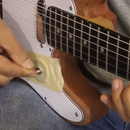Introduction: Level CNC Router Table Via Flycutting and Extra Support
So you just got a new CNC router. These devices are great for creating "stuff" from a variety of materials, even what you have just sitting around, but in order for your Z-axis to be accurate, you need to make sure the bed is level with the cutter's travel.
Step 1: Check and Add Support As Necessary
As seen in the project video, my bed wasn't fixtured to the base as solidly as it should have been. Don't be afraid to add more supports/screws as needed! In my case, this meant drilling through the metal frame underneath the MDF bed, then tapping it with a 1/4 - 20 tap. When cutting or tapping metal, be sure to go slow and use oil!
Also, think about where chips will land, and protect this beforehand.
This step, if needed, is best done before flycutting. In my case, I had to cut my bed twice, since I didn't realize that was (or would become) a problem.
Step 2: Flycut Table
The way to do this pretty simple in theory, just program your router to mill the entirety of your bed surface. Draw a pattern in CAD that will touch as much of the bed as you can, then program the router to follow it. This can be a repeating rectangular pattern as shown in part 1, or lines that go all the way to the end of one axis then back, over and over and over.
Start your router, plunge far enough so that the entire table will be cut level, then let it go to work! Sanding after this can help smooth out any tooling marks, but is optional.
Step 3: Check and Use!
A quick check to see if your bed is level is to simply hold the router at the same Z position, then slide it over the work surface. You can use a scale or piece of shim stock to see if it will still barely slide under from one end to another. Your bed should now be aligned!













